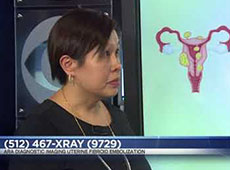Hysterosalpingogram (HSG) is a test that uses a technique called X-ray fluoroscopy to visualize a woman’s reproductive organs (uterus and fallopian tubes). This exam is used to help determine why a woman has difficulty becoming pregnant or to evaluate problems with miscarriages, tumors, adhesions, and fibroids. Fluoroscopy is a technique that uses real time X-ray images and a contrast agent to view organ anatomy, structure and function.
Please refer to the Fluoroscopy section for more information about this exam.
HSG is often used to evaluate why a woman has difficulty becoming pregnant. The test can help detect abnormalities of the uterus which may be the cause of infertility. HSG can be used to diagnose other problems in the uterus, such as:
- Tumors
- Adhesions in the uterus
- Uterine fibroids
Hysterosalpingogram is also used to evaluate conditions of the fallopian tubes, such as:
- Tube narrowing, blockage, or scarring
- Effects of tubal ligation or ligation reversal surgery
Benefits
- HSG is a minimally invasive exam that can accurately detect abnormalities in the uterus and fallopian tubes that may be preventing a woman to conceive or carry a fetus to term.
- In some cases, HSG will open the fallopian tubes allowing for the patient to become pregnant afterwards.
- HSG typically has no side effects, and no radiation remains in the body after the exam.
Risks
- Excessive exposure to X-ray exams might slightly increase your risk for cancer. However, if your doctor recommends the exam, it is because the benefit far outweighs this small risk.
- In some cases, this test may worsen conditions such as pelvic infection or sexually transmitted disease. Speak to your doctor or technologist about these conditions before undergoing the hysterosalpingogram.
- Tell your doctor or technologist if there is any chance that you are pregnant. It is best to avoid X-ray tests during pregnancy. Your physician may recommend an alternate exam.
- The risk of negative side effects due to contrast are rare. Refer to the Fluoroscopy section for more details about the risks of different types of contrast.
- Hysterosalpingograms are typically done in an ARA imaging center and usually take about 30 minutes.
- The procedure begins like a gynecological exam. You will be asked to remove all metal and jewelry, and you will be asked to change into an exam gown.
- After being placed on your back, your feet will be placed in stirrups. The radiologist or technologist will insert a speculum into your vagina. After the cervix is cleaned, and a catheter is inserted through the cervix into the uterus. Then the speculum is removed.
- The catheter will be used to gradually fill the uterus and fallopian tubes with contrast. You may feel some cramping or discomfort due to the contrast.
- As contrast enters the uterus and fallopian tubes, a special fluoroscopy camera will take pictures that can be recorded and viewed in real time on a monitor.
- If needed, you may be asked to wait for 30 minutes to have follow-up images taken.
- When the exam is finished, the catheter is removed, and you can sit up.
- You can return to your normal activities immediately.
- The hysterosalpingogram should be performed about one week after menstruation and before ovulation. This is to avoid the possibility that you are pregnant during the exam.
- Any pelvic inflammation or untreated sexually transmitted disease should be adequately treated before HSG. Ask your doctor about these conditions.
- The night before the exam, you may be required to take a laxative or an enema to clean out your bowels. This allows for better visualization of the uterus and surrounding anatomy.
- In some cases, a mild sedative or other medication may be given to reduce any discomfort. You may also be given an antibiotic to take before or after the HSG.
- Be sure to tell your doctor or technologist about any medication you take or if you have any allergies to contrast.
- If you are, or think you are, pregnant you should inform your technologist. Your doctor may recommend an alternate exam depending on your situation and symptoms.
To schedule a hysterosalpingogram (HSG), please call our scheduling team at (512) 453-6100 or toll free at (800) 998-8214. A provider referral is required to make an appointment.
A radiologist, a physician specifically trained to interpret radiological examinations, will analyze the images and send a signed report to the provider who referred you to ARA. The physician will then share the results with you.

 Back to Top
Back to Top